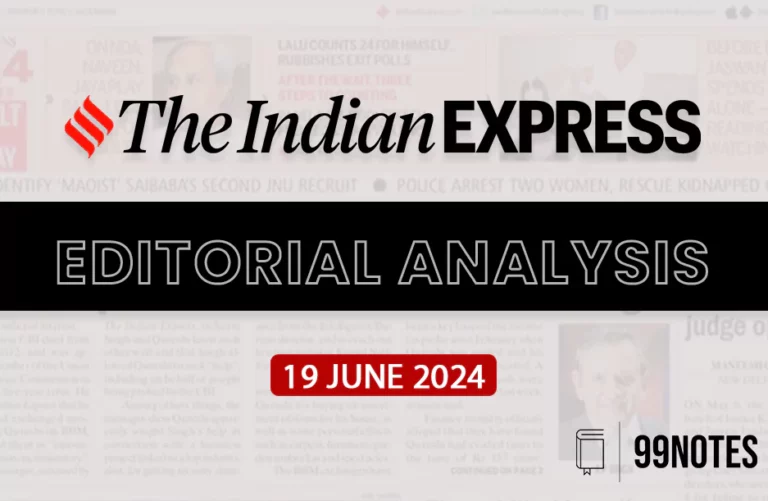19 April 2024 : Indian Express Editorial Analysis
Indian Express Editorial Analysis
19-April-2024
1. Clash of aspirations
|
Topic: GS3 – Indian Economy This topic is relevant for both Prelims and Mains as the analysis delves into India’s economic growth patterns over different periods and its evolving geopolitical role. |
| Context: |
|
Challenges to India’s Ambitions
Employment Dynamics and Demographic Dividend:
- India’s demographic profile presents both opportunities and challenges.
- With a median age of around 28 and a low dependency ratio, India possesses a demographic dividend, characterized by a large supply of young workers.
- However, leveraging this dividend entails addressing the challenge of matching these workers with productive employment opportunities, compounded by the ongoing transition from agrarian to non-agrarian sectors.
Labour Market Matching and Economic Transformation:
- The process of matching workers to jobs faces significant hurdles, including skill misalignment and geographical disparities between rural and urban employment opportunities.
- The transformation of India’s economy exacerbates these challenges, necessitating skill adaptation and potentially costly migration.
- Presently, the labour market appears to be struggling to effectively address these issues, as indicated by high unemployment rates, particularly among graduates and skilled workers.
Root Causes of Labour Market Dysfunction:
Firm Size and Productivity
- The relatively small size and low productivity of Indian firms constrain their demand for labor, contributing to unemployment and underemployment.
- This issue is compounded by a skill deficit, especially in the service sector, reflecting shortcomings in the education system.
- The mismatch between the skills demanded by firms and those possessed by workers further exacerbates unemployment rates, particularly among educated individuals.
Clash of Aspirations:
- A clash of aspirations emerges between entrepreneurs with limited growth ambitions and a burgeoning workforce with high educational attainment and lofty career expectations.
- While some firms achieve significant scale and competitiveness, many remain small, potentially due to regulatory constraints or a lack of ambition.
- Meanwhile, young workers, fueled by macroeconomic success narratives, aspire to meaningful employment opportunities beyond precarious gig work.
Path Forward: Addressing the Labour Market Crisis:
Incentivizing Export-Oriented Growth
- A potential solution lies in incentivizing private manufacturing firms to scale up and engage in export-oriented activities.
- Evidence suggests that exporting firms tend to be larger and more productive, offering opportunities for sustainable job creation and economic growth.
- Encouraging an export-oriented entrepreneurial mindset could help alleviate the clash of aspirations between workers and entrepreneurs, thereby maximizing the potential of India’s demographic dividend.
Policy Imperatives:
- Dealing with the unfolding labour market crisis demands urgent attention from policymakers.
- Prioritizing initiatives to address skill mismatches, promote entrepreneurship, and foster export-oriented growth should feature prominently on the government’s agenda.
- Failure to effectively harness India’s demographic dividend risks squandering its potential and exacerbating socio-economic disparities.
Conclusion:
- While India stands at a critical juncture with immense potential, realizing its ambitions hinges on addressing systemic challenges in the labour market.
- By fostering an environment conducive to entrepreneurship, skill development, and export-oriented growth, India can navigate the complexities of its demographic transition and emerge as a global economic powerhouse.
| What are the Opportunities of Demographic Transition in India? |
|
Enhanced labour Productivity:
|
|
PYQ: In the context of any country, which one of the following would be considered as part of its social capital? (2019) (a) The proportion of literates in the population (b) The stock of its buildings, other infrastructure and machines (c) The size of population in the working age group (d) The level of mutual trust and harmony in the society Ans: (d) |
| Practice Question: India’s demographic dividend has long been hailed as a potential catalyst for economic growth and development. However, the country faces numerous challenges in harnessing this demographic advantage effectively. In light of this, discuss the key impediments to realizing India’s demographic dividend and propose policy measures to address them. (250 words/15 m) |
2. India’s 4P model
|
Topic: GS2 – Governance – Government policies – Interventions for development in various sectors This topic is relevant for both Prelims and Mains as the analysis delves into the role of political leadership and public financing in driving transformative initiatives like the Swachh Bharat Mission (SBM). |
| Context: |
|
Political Leadership: The Catalyst for Change:
- Political leadership, embodied by Prime Minister Modi, played a pivotal role in driving transformative change through initiatives like the Swachh Bharat Mission (SBM).
- It was Modi’s decisive leadership that propelled India to confront the challenge of open defecation head-on, restoring dignity and security to communities, particularly women and girls.
- By setting ambitious goals and closely monitoring progress, Modi galvanized national efforts towards achieving a clean India.
Public Financing: Investment in Development:
- The commitment of public financing to sanitation, as a high-level policy decision, underscored the recognition that investment in sanitation is integral to poverty reduction and enhancing quality of life.
- With investments totaling $20 billion, the Indian government demonstrated its commitment to financing initiatives that contribute to sustainable development.
- This commitment also resonated globally, inspiring other nations to prioritize sanitation as a national developmental priority.
Partnerships: Collaborative Endeavors:
- Partnerships were instrumental in the success of the SBM, with collaborations extending across international bodies, NGOs, local administrations, and community organizations.
- The SBM was not merely a government program but a collective effort involving diverse stakeholders united by a common goal.
- The effectiveness of these partnerships was further amplified by the active involvement of Prime Minister Modi as a communicator-in-chief.
People’s Participation: Empowering Communities:
- The hallmark of the SBM was its emphasis on people’s participation, empowering communities to take ownership of sanitation initiatives.
- Rural communities across India embarked on mass movements to achieve open defecation-free status, with women and girls emerging as leaders in their own right.
- This grassroots engagement not only ensured the success of the program but also laid the foundation for its sustainability.
Conclusion:
- India’s 4Ps, forged through initiatives like the SBM, offer valuable lessons applicable to a range of developmental challenges.
- As the world strives to achieve the Sustainable Development Goals (SDGs) and address global challenges such as climate change and pandemics, the significance of political leadership, public financing, partnerships, and people’s participation, exemplified by Prime Minister Modi’s leadership, has never been more pertinent.
| Achievements of the Swachh Bharat Abhiyan in promoting cleanliness and sanitation: |
|
Sanitation coverage in India:
|
| PYQ: ‘To ensure effective implementation of policies addressing water, sanitation and hygiene needs, the identification of beneficiary segments is to be synchronized with the anticipated outcomes’ Examine the statement in the context of the WASH scheme. (150 words/10m) (UPSC CSE (M) GS-2 2017) |
| Practice Question: Discuss the significance of India’s 4Ps – political leadership, public financing, partnerships, and people’s participation – in driving transformative initiatives such as the Swachh Bharat Mission (SBM). How do these principles contribute to effective governance and sustainable development? Illustrate your answer with relevant examples. (250 words/15 m) |
For Enquiry

19 April 2024 : Indian Express Editorial Analysis

18 April 2024 : Daily Current Affairs Quiz

18 April 2024 : Daily Answer Writing

18 April 2024 : Daily Current Affairs

18 April 2024 : PIB Summary for UPSC

18 April 2024 : The Hindu Editorial Notes PDF Copy

18 April 2024 : Indian Express Editorial Analysis

17 April 2024 : Daily Current Affairs Quiz

17 April 2024 : Daily Answer Writing

17 April 2024 : Daily Current Affairs
April 2024 Indian Express 19 April 2024 : Indian Express Editorial Analysis Indian Express Editorial Analysis
18-April-2024
1. Clash of aspirations
Topic: GS3 – Indian Economy
This…
Daily Quiz 18 April 2024 : Daily Current Affairs Quiz 18- April 2024 : Daily Quiz…
mains answer writing 18 April 2024 : Daily Answer Writing Mains Answer Writing
18-April-2024
Q1) Limiting the country’s fiscal deficit is a cherished goal, but…
April 2024 Daily Current Affairs 18 April 2024 : Daily Current Affairs Daily Current Affairs
18-April -2024- Top News of the Day
1. ICMR Initiates Study to Address Maternal…
April 2024 PIB 18 April 2024 : PIB Summary for UPSC PIB Summary for UPSC
18-April-2024
1. SPACE, a premier testing & evaluation hub for sonar systems…
April 2024 The Hindu Editorial 18 April 2024 : The Hindu Editorial Notes PDF Copy The Hindu EDITORIAL
18-April-2024
1. The Great Indian Bustard and climate action verdict
Topic:…
April 2024 Indian Express 18 April 2024 : Indian Express Editorial Analysis Indian Express Editorial Analysis
18-April-2024
1. A trusted mediator
Topic: GS2 – International…
Daily Quiz 17 April 2024 : Daily Current Affairs Quiz 17- April 2024 : Daily Quiz…
mains answer writing 17 April 2024 : Daily Answer Writing Mains Answer Writing
18-April-2024
Q1) Domestic demand has been the north star of India’s economic growth;…
April 2024 Daily Current Affairs 17 April 2024 : Daily Current Affairs Daily Current Affairs
17-April -2024- Top News of the Day
1. SC Bench opposes returning to paper ballots…




